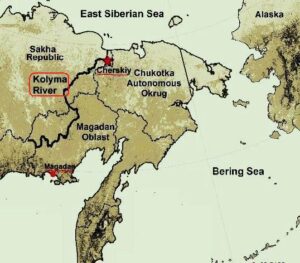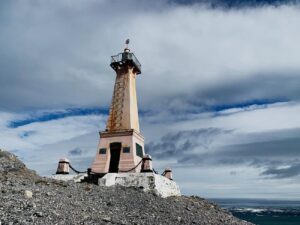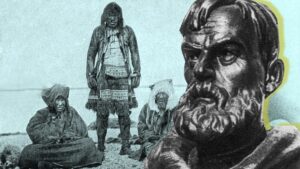Biography:
Semyon Dezhnev is an explorer who became famous for his exploration of Siberia. His travel notes became a source of knowledge for both his contemporaries and subsequent generations. And the traveler’s discoveries allowed him to add new territories to the map of Russia. In this way, he left his mark on history forever.
Childhood and youth:

According to popular information, Semyon Dezhnev was born in March 1605 in what is now the Arkhangelsk region. The boy spent his early life in the village of Esipovskaya in the Pinezhsky district. He is considered to be from a family of Pomor peasants.
Even as a child, Semyon demonstrated an interest in traveling. As a teenager, he went by sea with his father to the Solovetsky Islands to deliver gifts to the local monastery. And at the age of 17, the young man moved to Arkhangelsk to serve a wealthy merchant. He became a sailor on a sailing vessel called a koch and took part in a small expedition.
Campaigns:

In 1630, free men were recruited for service in Siberia. Tobolsk needed 500 men, among whom was Dezhnev. The detachment that was sent to distant lands was formed in Veliky Ustyug.
The men went to the northern reaches for various reasons: many were attracted by the desire to become a pioneer, others were lured by stories about Siberia, generous with its riches. Almost everyone hoped that the journey would bring them prosperity.
Service in 1630-1638 in Tobolsk and Yeniseisk, where Semyon Ivanovich was later transferred, brought Dezhnev together with pioneers who later became his associates in the study and development of new territories. At the end of this period, he transferred to the Yakutsk prison.
Researchers highly value the diplomatic skills of the famous traveler. He was distinguished by his calmness, peacefulness, and always tried to avoid bloodshed, if possible. There is a lot of information about how Semyon Ivanovich reconciled warring clans and established relationships with them.
In 1640, Dezhnev distinguished himself by reaching an agreement with the rebellious prince Sahei, who refused to pay yasak to the Russian authorities despite the peace agreement. Three brave Cossacks sent to him before that were killed. Semyon Ivanovich did not start a conflict, but entered into a peaceful dialogue with the rebel, and as a result, the difficult task was completed.

When Mikhail Stadukhin arrived in Yakutsk, Dezhnev joined his detachment and went to Oymyakon to collect yasak from the Evenks and Yakuts. Having made a difficult journey through the high ridges of the Verkhoyansk Range and reached the Indigirka River, the participants of the expedition heard from the locals about a certain full-flowing river Kovyma (Kolyma). Subsequently, they became its discoverers.
In the new location, the detachment founded a winter hut – the Srednekolymsk fort. Later, Semyon Ivanovich also discovered Nizhnekolymsk. In 1645, Stadukhin left for Yakutsk to deliver the collected yasak there. Dezhnev and his team had to fight off raids by the local population; about 500 Yukaghirs were destroyed.
One day, Semyon Ivanovich learned about the expedition of Fedot Popov (Kholmogorets), the purpose of which was to find the Pogycha River. They said that the area there was rich in “soft junk” and “fish teeth”, as sable furs and walrus tusks were called in those days. Dezhnev wanted to join this journey.
The first attempt at the expedition, undertaken in the summer of 1647, was unsuccessful. A year later, the team set out on a second expedition by sea. It was dangerous: out of 90 participants, only a minority reached the final destination. Semyon Ivanovich was among them.
The value of this journey is not only in the fact that Dezhnev managed to find a large walrus rookery. It is believed that the travelers were the first to sail through the Bering Strait even before it was named in honor of Vitus Bering. Thus, without knowing it, they proved the “separateness of the Asian and American continents.”

The cape in the strait, past which the travelers sailed and which they called the Big Stone Nose, is the extreme northeastern point of Asia – it was later called Cape Dezhnev. There is an assumption that Semyon Ivanovich also reached Alaska, which was within the power of the brave sailor.
During the journey, the team split up. Popov’s ship washed up on the shores of Kamchatka, where the merchant died of scurvy two winters later. On October 1, 1648, Dezhnev landed in Olyutorsky Bay with the remaining 24 sailors and reached the mouth of the Anadyr River by winter. They set up winter quarters there.
Later, the detachment began building new boats, which they used to travel up the river mouth. The Anadyr prison was founded there, where Semyon Ivanovich spent several years of his life. During this time, he made a map of Anadyr, described in detail the voyages along the river and the nature of the region, and told about the Eskimos living on the shores of the Chukotka Peninsula and on the neighboring islands.

In the fall of 1650, Dezhnev made an unsuccessful attempt to reach the Penzhina River (Kamchatka Krai) and returned back. But the traveler did not arrive in Yakutsk empty-handed. It was at this time that he came across a walrus rookery on the shallows and began to collect tusks. All this time, he constantly had to look for ways to interact with the local population, in which his diplomatic skills again helped.
Semyon Ivanovich left the Anadyr prison only in 1662. He went to Yakutsk to deliver yasak, sable furs and walrus ivory there. Later, the traveler was sent to Moscow, where he received his due reward and payments for honest service. This made him a wealthy man. In addition, by the tsar’s decree, Dezhnev was appointed a Cossack ataman.
Semyon Ivanovich returned to Yakutsk. He was no longer young, did not make large trips, but continued to collect tribute. In 1672, Dezhnev again found himself in Moscow and was no longer able to leave due to health reasons.
Personal life:

Dezhnev had two wives in his personal life, both Yakut. The navigator’s first chosen one was Abakay da Sichyu, who bore him a son, Lyubim, who later served in the Yakut Voivodeship. It is known that before her husband’s departure on another campaign, Abakayada was baptized by a local priest and received an Orthodox name. But she did not live to see her husband return from the journey.
When Dezhnev returned from Moscow in 1665, he married the widow of a deceased local blacksmith, Kanteminka (Kapka). The woman was not young, and she had a son, Osip, from her first marriage. She inherited property from her deceased husband – hayfields on an island near Yakutsk. Semyon Ivanovich pledged to take care of his stepson and look after the farm.
In his second marriage, Dezhnev had a son, Afanasy, who later, like his father, served on Anadyr. Various documents mention a certain Pelageya – historians assure that this is not the traveler’s third woman. This is the Christian name that Kapka was given at baptism.
Death:

Years of severe trials with cold and hunger, difficult campaigns in winter and summer, as well as numerous wounds undermined Semyon Ivanovich. In the capital, he fell seriously ill, weakened and took to his bed.
The explorer lived in Moscow for about a year and died at the beginning of 1673 – this is stated in the “tax book” of the servicemen of Yakutsk. At the time of his death, Dezhnev was about 70 years old. The cause of the traveler’s death is considered to be poor health.
Where the ataman’s body rests is unknown. In the 17th century, it was not customary to make common cemeteries in Moscow — the deceased were buried next to parish churches, and there were many churches in the capital.
Memory:

The great Russian explorer is remembered and honored centuries after his death. Surviving records and portraits serve as reminders of him. A bay, streets, an asteroid, and a variety of a plant called spleenwort were named after him.
At various times, an icebreaker, a motor ship, and a steamship were launched, named after Dezhnev. In his memory, a prize was established, a postage stamp and a coin were issued. A river school named after Semyon Ivanovich was opened in Novosibirsk.
In 1983, the premiere of the feature film “Semyon Dezhnev” took place, where the traveler was played by Alexey Buldakov.
Discoveries and achievements:
- discovered the Kolyma River.
- discovered the strait separating two continents.
- was the first to cross from the Arctic Ocean to the Pacific Ocean.
- discovered the Anadyr River and explored its basin.
- explored the eastern end of Asia.
Interesting facts:
- Some researchers believe that Semyon Ivanovich was born in Veliky Ustyug. A monument to him was erected there.
- Dezhnev was illiterate, so other people wrote replies and petitions for him under his dictation – they also signed for the ataman if necessary.
- The name of the discoverer is placed on a par with such conquerors of Siberia as Vasily Poyarkov, Erofey Khabarov, Ivan Moskvitin.
